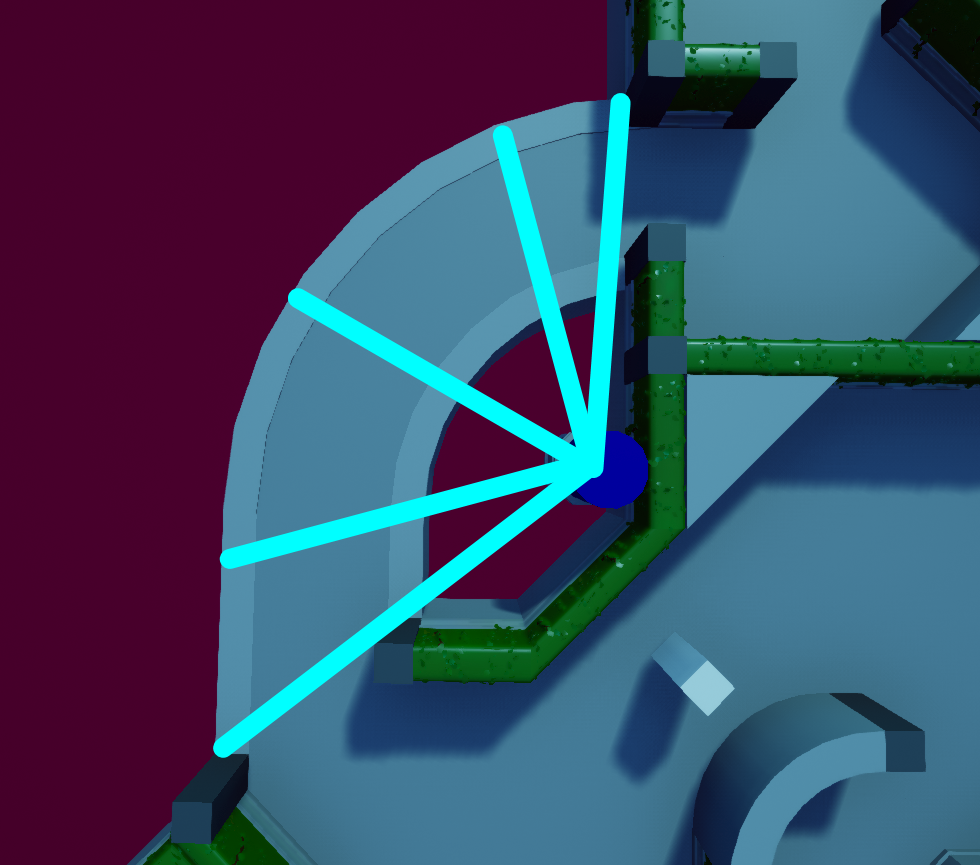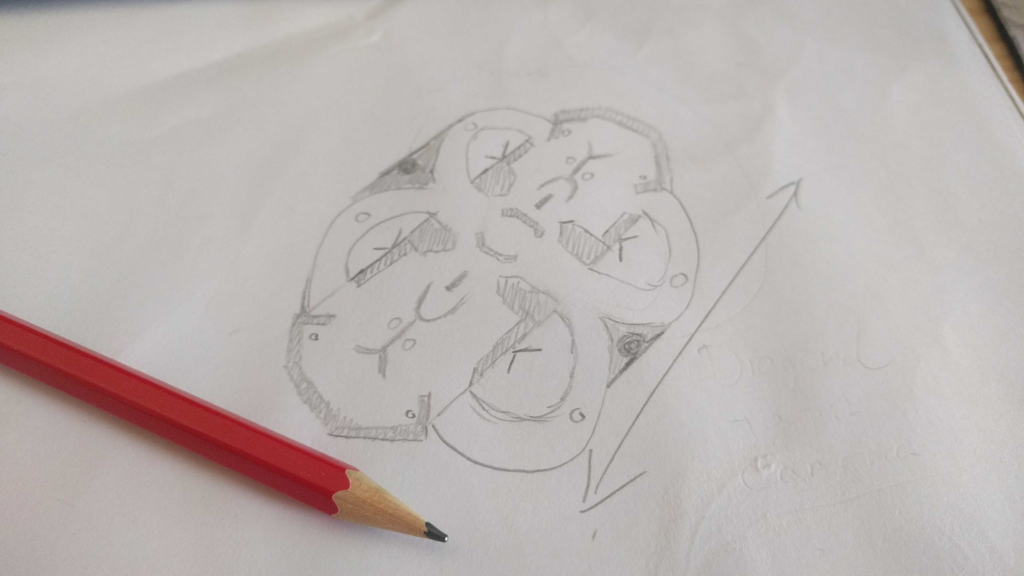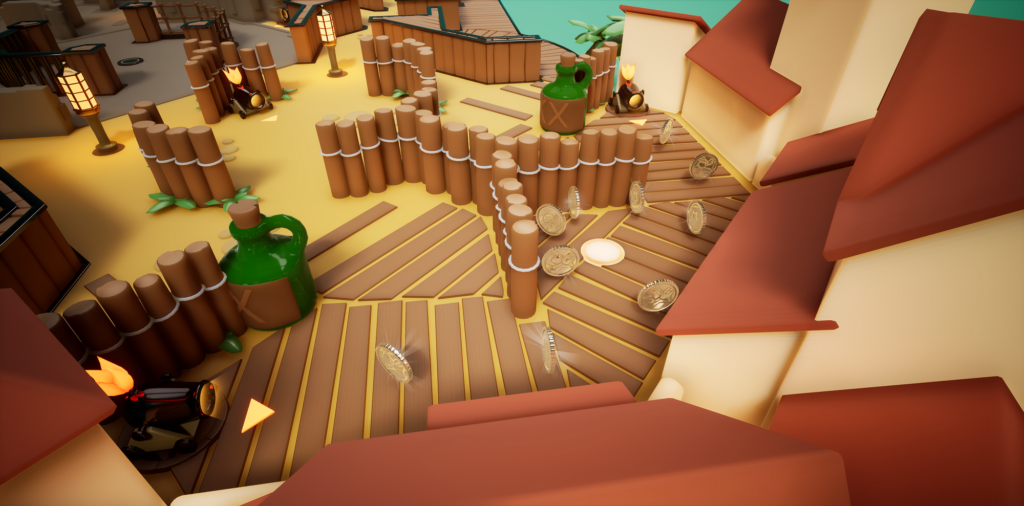Blocktober: Outcasters
October 14, 2020
Welcome to Blocktober! Blocktober is an annual celebration of all things Level Design. This year we wanted to show off some of the amazing work our Level Designers have done on three of our games. One this week, one next, and one in the final week of October.
We won’t spoil the surprise, but make sure you’re following us on Twitter, Instagram, Facebook, or subscribed to our newsletter, to see when the next articles go live.
As ever, we’re hiring! So if you’re looking for a new challenge on some exciting projects, then check out our open roles.
The first game we wanted to show off is Outcasters, our upcoming Stadia title. There’s no better map to talk about than Lucky’s Lagoon; you’ve already seen it in trailers, and in a host of screenshots. It’s the perfect map to demonstrate some of the planning, thinking, and theory our Level Designers put into our games.
We sat down with two of them, Midas (Level Designer), and Safal (Production Tester on a Level Design secondment) to talk about their work on the map. How and why the players spawn where they do, why hazards are placed in certain areas, and even how it was transformed to work with a whole new game mode!

ABOUT LUCKY’S LAGOON
Lucky’s Lagoon is a level designed for the Last Caster Standing (LCS) game mode in Outcasters. LCS pits 8 players against each other until there is only one left alive. When time runs out, a Ring of Doom will gradually constrict the available gameplay space, pushing everyone towards the centre of the map for a final stand-off, ensuring there’s tension throughout the whole match!

HOW DO YOU START DESIGNING A LEVEL FOR OUTCASTERS?
Midas: Making a level for Outcasters is very satisfying because the primary focus is on creating something that is just fun. Our levels don’t have to resemble anything hyper-realistic so we can get away with some really funky shapes that make for engaging projectile-curving gameplay. This focus on gameplay was a very deliberate choice from the start of the project, and meant we only needed two things to start designing a level for Outcasters:
Firstly, you need a clear understanding of the required gameplay elements for a level to function (things like a certain number of player spawn points, the intended match duration, a configured Ring of Doom etc). It’s important to have a clear idea of what is required for gameplay elements to function properly because their specific requirements are likely to inform the structure of the level in one way or another. To give you an example: generally, you don’t want players to spawn right on top of each other, because that’ll get boring quick, so that requires the spawn points to have a certain amount of space between them.
Secondly, you need a unique gameplay “hook” (idea) that sets the level apart from the others in the game.
Because the required gameplay elements are established entities, the focus at the conception of a new level tends to be on the creation of the hook. These hooks are often born from using existing gameplay elements in a fun, novel way (which was especially true for Outcasters since we were a small team that needed to work efficiently back then). So, think of things like; using sets of moving walls to create opportunities for players to trap & push their opponents off a ledge, or using shooting statues to cover powerful Power-ups. There are so many different elements to combine, you can easily come up with something that hasn’t been tried before.
IS THE STARTING POINT DIFFERENT FOR DIFFERENT TYPES OF GAME?
Midas: Definitely! One reason Level Design is such a difficult discipline to define and discuss is because the specifics vary quite a bit from game to game. Different genres (even game modes) require different steps. You’d be doing a lot more research and reference gathering to inspire and solidify the realism of your level in a story-driven game like Gears Tactics than you would for a multiplayer game like Outcasters. However, in my experience Level Design philosophies and processes often have a lot of overlap.
For instance, making something unique is a goal that should apply to all good LD processes in some shape or form. But the way that this goal is achieved can be wildly different. For instance, the unique features in multiplayer levels for Outcasters can be relatively simplistic and still have an impact on gameplay, since the most interesting ‘content’ in multiplayer games comes from players interacting with each other. While in singleplayer games, like Gears Tactics, the complexity and scale of each level needs to be far more layered to still effectively impact the experience in a memorable and unique way.
WHERE DID YOU START FOR LUCKY’S LAGOON?
Midas: For Lucky’s Lagoon, I set out with the goal of creating unique player-activated traps that would give the level its own identity. It’s almost always more fun if players have some form of input and agency because it expands their opportunities to learn and master the level.
I made three main traps for Lucky’s Lagoon, all by using existing gameplay mechanics:

The Power-up Ambush
This trap can be activated by shooting the statues (the blue pillars). Which then fire a splitting projectile that scatters over the Power-up. This allows players to deliberately create a dangerous risk/reward proposition for their opponents.

The Death Slinky
This rotating statue shoots a string of projectiles that will hit anyone located on the curved bridge. Players will have to wait and time their shots exactly right to catch their opponents off guard!

Fire Tornado
My absolute favourite bit about Lucky’s Lagoon is this central area (it’s the idea that started the level). I wanted to create a way for players to deliberately trap and duel each other. In the end, I created this death spiral in the centre by combining wall-running projectiles with a very specific setup of walls.
WHY IS LUCKY’S LAGOON THIS ELONGATED SHAPE?

Midas: As opposed to the generally square/round Outcasters levels? That’s a lovely question, with several answers!
It mainly came about because I originally wanted to spawn three players within view (but out of reach) of each other, to create some tense The Good, The Bad and The Ugly-like stand-offs at the start. We became massive fans of the “Stand-Off” spawn setups after Senior Level Designer Mirek Slowik made one on his Space Station level, so you’ll see them across many of our maps, though up until Lucky’s Lagoon we’d never tried one with three players.


Having accounted for six out of eight player spawns, where do you put the remaining two? I thought that the most reasonable use of space would have them be placed between the stand-offs, especially considering how nicely this’ll compliment the flow of battle. As a result, you can see that the level already forms an elongated shape, simply by planning out the spawn points.
However, this ‘Three-Player-Stand-Off’ setup hasn’t made it all the way into the final product! This is because the game mechanics evolved over time and required the map to evolve with it. Back when the original blockout was created, we didn’t have Power-up “stacking”, so the amount of Power-up spawns in the map was far less than it is now. However, to support the new requirements, more Power-up spawns had to be added, prompting Saf, who took over ownership of Lucky’s Lagoon, to move the ‘middle’ spawn point elsewhere to create space for a new Power-up spawn.

Now the level isn’t just built rectangularly, but also diagonally. I wanted to discover what novel gameplay implications building a level on a diagonal axis would have. Since the very basic Modular Kit we used already started showing repetitive shapes in my other levels, I wanted to flip it on its head and see where I could take it!
For those unfamiliar with the term “Modular Kit” it’s basically a small set of digital “Lego bricks” of different shapes and sizes that we use to construct the level with. You can probably tell some pieces apart by looking at the images shared throughout this article.

Building the level diagonally allowed me to create several interesting geometrical shapes and patterns that we hadn’t seen before, and to create new nooks and crannies for players to hide in and fight around. At the time of building the blockout, the player camera was also still perpendicular to that of the Modular Kit, creating a rather cool visually distinct experience, again simply by building the map on an angle. However, this was later implemented throughout Outcasters, by offsetting the camera at an odd angle for the entire game. This creates far more engaging visuals than with a perpendicular camera.
HOW DO YOU KEEP THINGS EXCITING AND FRESH IN YOUR LEVELS?
Midas: As all Level Designers know, players have the freedom to go and do as they please. This means that we have to find ways to encourage them to engage in fun gameplay without making it feel forced. One way to explain how we achieved this in Outcasters is through the lens of our three combat phases:
1. SPAWNING PHASE
We can easily predict and design for the player experience at the start of the round, aka the Spawning Phase. This is because we know where players spawn and what they see. This allows us to give them visual hints (such as gaps that frame available routes or a glimpse at the locations of other players etc) softly nudging them into cool gameplay opportunities. On Lucky’s Lagoon, we spawn several players within view of each other, immediately creating a “what are they gonna do?” tension. Then, to make things even more interesting, we also place a Power-up between them. This immediately proposes interesting questions: Do I go on the offensive? Defensive? Do I run away? Do I go for the Power-up? Will they? This creates a lot of gameplay options for players to choose from!
2. ROAMING PHASE
Then we enter the Roaming Phase, which is the most difficult to curate since players can just freely… well… roam! My personal approach to multiplayer design is to create enticing combat hotspots and connect these up. In general, these hotspots are designed to revolve around important items, such as Power-ups, or placed on important junctions where players are likely to meet. In Outcasters the levels are relatively small, so every bit of space counts and has to serve a purpose (preferably more than one). This results in the whole map becoming one massive collection of interlocking combat hotspots. This allows players to be able to have interesting fights anywhere in the level.
But how do you make a map fun and interesting to play over and over? The key is offering a variety of choices and approaches, more than players can try in a single round. You want to entice them into thinking “Next time if I spawn here I’m going to go left instead of right.” This stops engagements from becoming stale and predictable.
3. FINALE
Lastly, we get to the Finale, which is tightly controlled by the Ring of Doom. The Ring of Doom constraints the available playspace for the remaining players, making it easy for us to create high-pressure mini-arenas. Before we introduced this, we ran into what I jokingly referred to as the “Washing Machine”; the last two or three Players would endlessly walk around the edges of the level in circles, constantly missing each other. By shrinking the available playspace we confined the players’ movement, helping us keep up the intensity.
On Lucky’s Lagoon, I wanted to make sure that the central area gave players enough movement options so they wouldn’t just camp in a corner and spam projectiles. I also wanted to set it apart from the other maps, by building my main unique gameplay hook (the Fire Tornado), slap bang in the middle of it!
CAN YOU EXPLAIN THE THINKING BEHIND SOME OF THE LEVEL DESIGN ‘RULES’ FOR OUTCASTERS MAPS?
Midas: Absolutely! There are quite a few interesting things we learned as we explored the in’s and out’s of Outcasters Level Design. From our early playtests we developed guidelines on how structured our levels had to be. Many of our initial layouts had combat distances that stretched across the entire map. This meant that players could get hit by projectiles fired by another player on the other side of the map. That wasn’t fun for either player and gave us a good indication of how constrained our combat spaces needed to be.
Another cool thing we learned along the way is that we have to keep the overall shapes of walls and cover as simple as possible (while keeping them as interesting to play around as possible). The rounds in Outcasters are short by design. That means that new players have very little time to familiarise themselves with a layout, especially when they’re being shot! So keeping things readable at a glance allows them to immediately grasp what they’re in for. Another reason for clean shapes is that we have Power-ups in the game that allow you to bounce projectiles off walls. To make sure the player can reasonably predict where their projectile will bounce, straight walls need to be perfectly straight, and curved walls perfectly curved. This enforces a clean and clear visual language.

ABOUT BUCCANEER BAY
Lucky’s Lagoon was also used as the basis of a new level in the “Gold Rush” game mode; Buccaneer Bay. It maintains some elements you’ll recognise from Lucky’s Lagoon but has changed in some important areas to suit the new game mode.
Gold Rush pits two teams of four against each other in a race to collect, and then Bank, coins spread all over the level. The Banking Areas are designed and placed to create tense combat situations between the teams.
Safal will now talk a little about his process in adapting the original layout, what he had to change, what he wanted to keep and what he thought about when designing Banking Areas.
HOW DID YOU HAVE TO CHANGE THE LEVEL TO WORK WITH THE GOLD RUSH GAME MODE?
Safal: When we began, we copied the layout of Lucky’s Lagoon exactly, and only updated the game mode to be Gold Rush. With this experimental approach, we wanted to prove if it was feasible to have multiple game modes use the same layout, to keep the learning curve for players relatively low.
This approach showed that adapting existing maps was certainly viable, but we discovered that we needed to make quite a few changes to allow the mode (and especially the Banking Areas) to shine. For instance, we noticed immediately that it would be much better for players on the same team to spawn next to each other, ensuring they work together. This meant we had to create more dedicated spaces for spawnpoints.
We also noticed that we needed to focus our design efforts on the Banking Areas themselves since players spent most of their time fighting near them.
You can see the transition from Lucky’s Lagoon’s layout, to Buccaneer Bay’s, to final art, below.
WHAT WAS YOUR THINKING BEHIND THE CREATION OF THE BANKING AREAS?
Safal: We wanted each Bank to have its own unique gameplay moments while keeping their layouts relatively simple. In Buccaneer Bay, I used the shooting statues that made the original map (Lucky’s Lagoon) memorable and focused the design of the Banking Areas around them.
In the below example, we have a ‘Wallrunner’ statue pointed at the Banking Area. The statue can be activated by either team and once triggered it will fire multiple ‘Wallrunner’ projectiles creating a temporary hazard for players. The benefit of ‘Wallrunner’ projectiles is that they cruise along the walls, so we’re combining a cool hook (the statue) with relatively common static geometry.
WHAT WAS YOUR THINKING BEHIND THE COIN SPAWN LOCATIONS?
When we started Gold Rush we used to spawn the coins in specific spots in the map, however, now they spawn in semi-random places. This was a conscious decision after playtesting showed that players would rather camp the predictable coin spawns as opposed to fighting over the Banking Areas. This went against our design philosophy for Gold Rush, so we came up with the possibility for coins to spawn anywhere in the map. We did add some control over where the coins can spawn, to curate the experience a little, like here:

In this example, you can see a cluster of coins spawn in the projectile paths of the shooting statues. Playing into the existing tactical opportunities of the map.
On top of this, there are some clever systems in place where coins don’t spawn right next to a player, enticing them to keep exploring and keep moving.

Phew. That’s the first of our Blocktober articles done. Thank you so much for reading, and to Midas and Safal for giving up their time to talk about their work.
As we said at the start, we’re uploading two more articles detailing the level design processes of two of our other games. One next week, and one the final week of October.
Make sure you’re following us on Twitter, Instagram, Facebook, or subscribed to our newsletter, to see the next articles. You won’t want to miss them.
